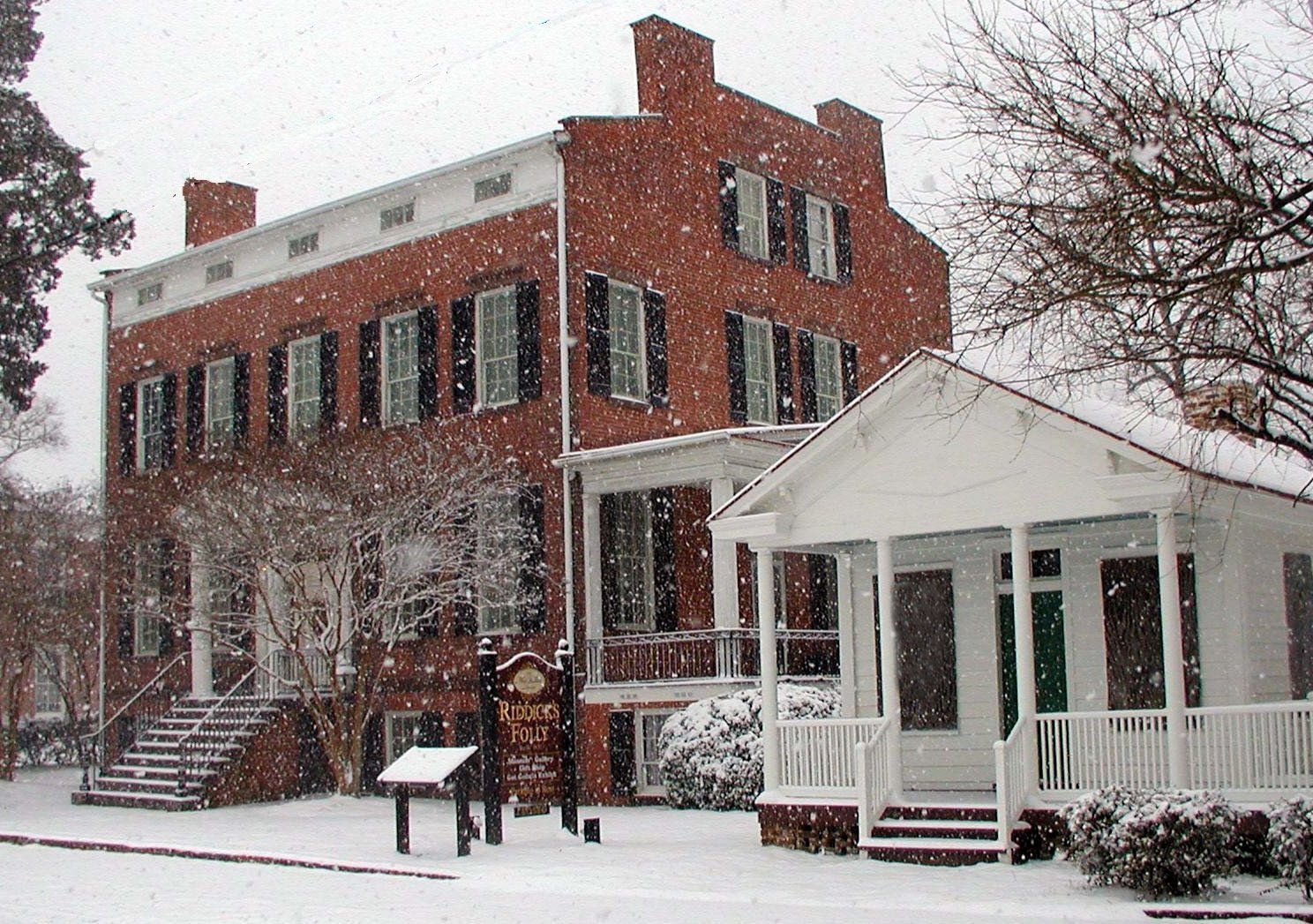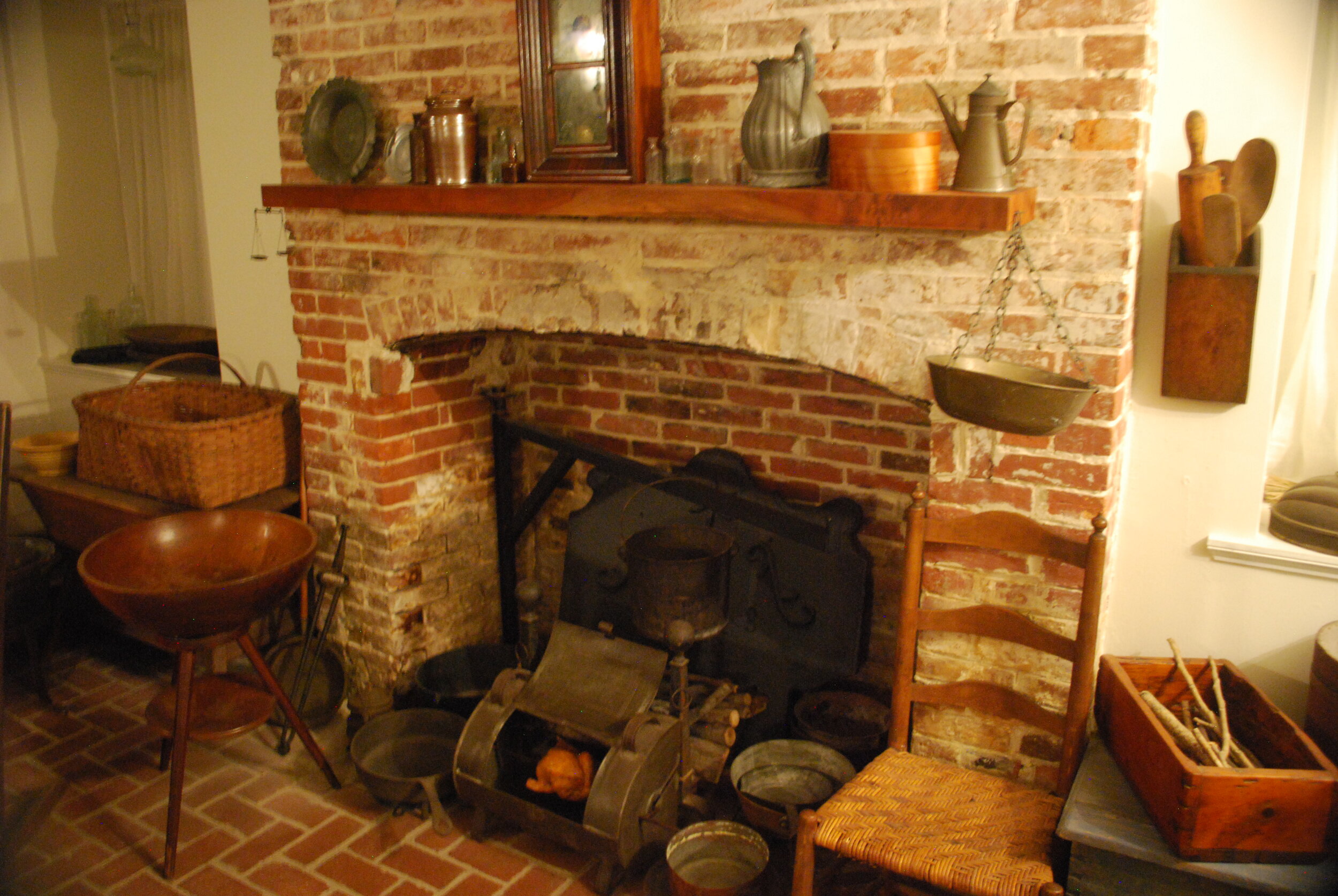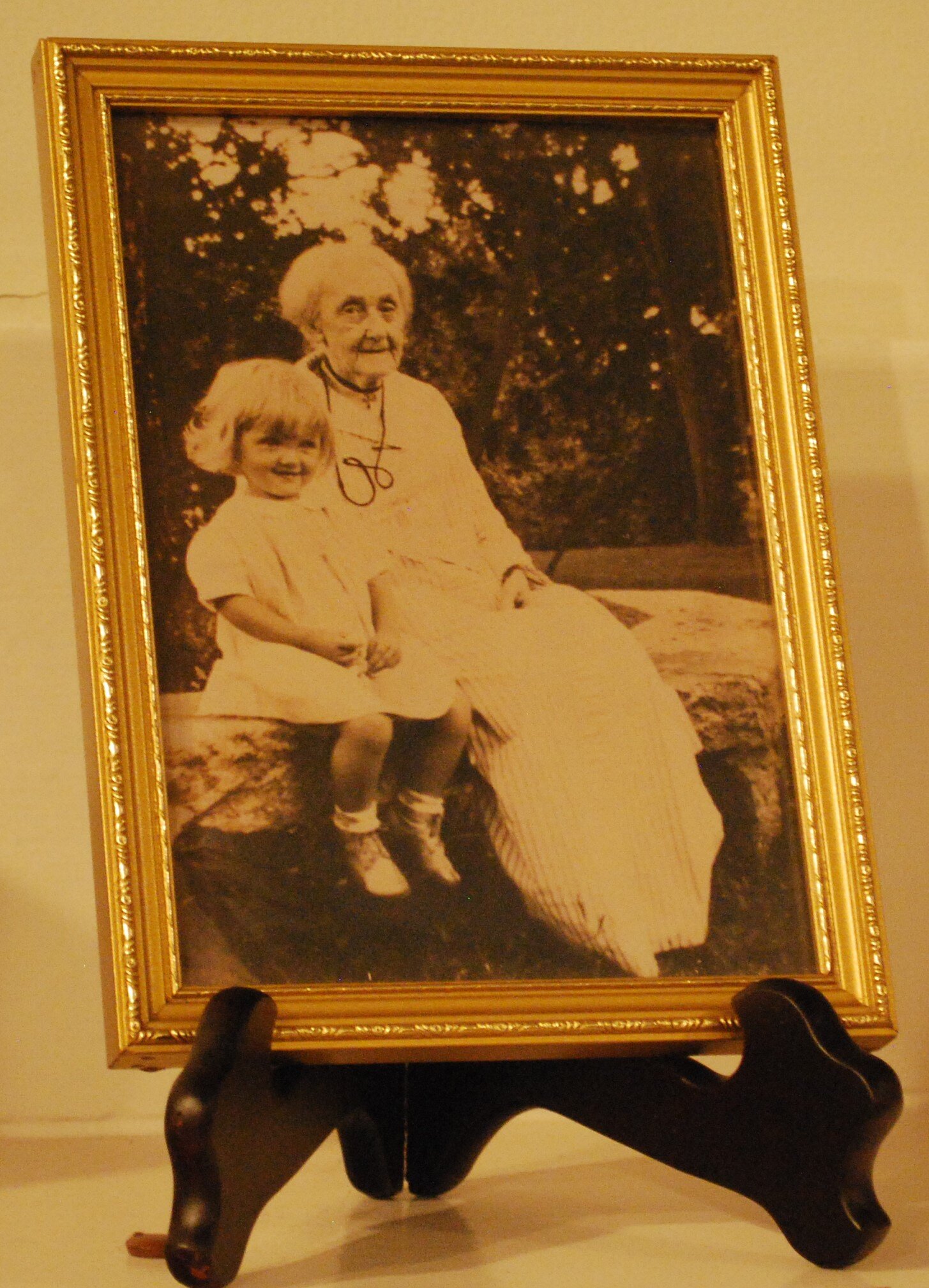Traveling to History: Twelve
BRICKS, MORTAR, AND LOTS OF STORIES: A VISIT TO RIDDICK’S FOLLY
By James F. Lee
The Riddick House in the snow. This elegant Greek Revival mansion was called Riddick’s Folly by neighbors. The name stuck. (Courtesy of Riddick’s Folly)
Houses are more than bricks, joists, and beams. Houses are the stories of the people who inhabit them. We found that out recently visiting the Riddick House in Suffolk, Virginia.
This four-story, 21-room Greek Revival mansion completed in 1839 is notable by its low windows on the top floor and double chimneys on either end. It was built on the site of an earlier house that burned during Suffolk’s big fire in 1837.
The owner of this stately home, Mills Riddick, was a very wealthy man, and he didn’t mind showing off his status. He owned several plantations, and made a fortune in the lumber business, using enslaved laborers to harvest lumber in the Great Dismal Swamp.
Given the house’s size, his incredulous (or envious) neighbors labelled it Riddick’s Folly.
The name stuck.
This portrait of Mills Riddick was done by his grandson George H. Riddick. (Photo by James F. Lee)
“It was a joke in 1837,” said Director/Curator Edward L. King. “There was nothing else like it in Suffolk.”
Except for several years during the Civil War, the Riddick family inhabited the house until 1967 when it was sold to Nansemond County (now the City of Suffolk). Because of that long occupancy by the family, visitors today get to see lots of original furnishings, clothing, artifacts, and personal belongings throughout the house.
My wife and I visited recently on a warm summer morning. We were greeted at the front door by our guide, Joyice Jones, who led us into the formal parlor on the first floor. A black Italian marble fireplace, original to the house, caught our eye as we entered the parlor. On the walls are portraits of Mills Riddick and his wife Mary Taylor Riddick, a descendant of the Allen family of Bacon’s Castle fame. In the middle of the room is a lovely green sofa in pristine condition brought here from one of Riddick’s plantations when the family moved in.
Joyice pointed out that the framing of the house was constructed of heart pine. The floorboards in the parlor are 20 feet long, and an inch-and-a half thick, with no knots. On the doorways in this room, corner blocks painted in 24-carat gold leaf added to the air of wealth. Folly or not, this is a well-constructed house built with no thought of sparing expense.
In this room we learned our first story as we admired a framed needlepoint on the wall. Fourteen-year-old Missouri Ann Jones Kilby, a student at St. Joseph’s Academy in Maryland, created this bucolic nature scene with trees, water, and distant mountains around 1835. It is easy to picture her laboring over the neat stitching. She even won a prize for it.
Missouri later married Nathaniel Riddick, the 10th child of Mills and Mary Riddick, eventually becoming mistress of Riddick house.
But the story doesn’t end there.
A portrait of Mary Taylor Riddick in the formal parlor. Note the Joseph Hisky piano (1825) with painting above the keyboard. (Photo by James F. Lee)
The piece was long missing, taken by a Union soldier when the house was occupied by the United States Army during the Civil War. Years later, finders in New York alerted the curator to its location.
“It was missing for 136 years before it got back here,” said Joyice. “It’s in its original frame, so whoever had it took good care of it.”
Nathaniel Riddick became the owner of the house after his father’s death in 1844. He and Missouri had six children, the eldest of whom, Anna Mary Riddick, was the first child born in the house in 1841. Except for the Civil War years, she resided her entire life in the house, where she died in 1936.
Anna Mary’s story is a tragic one. Joyice showed us a large painting in the foyer of a dark, brooding coastal scene done by Anna Mary in 1862. The painting reflects her mood. Anna Mary had fallen in love with Jonathan Reynolds Smith, her younger siblings’ tutor. He proposed to her, giving her a ring with her name engraved on it, and vowed to marry her after his return from the war. In July of that year, Smith was killed at the Battle of Malvern Hill, fighting for the Confederacy. Anna Mary never married and wore mourning black for the next 25 years.
This painting had also been removed from the house and was later purchased by a benefactor who donated it back to the museum.
Joyice then led us to the gentlemen’s parlor, for a time as Nathaniel’s law office. He also served as mayor of Suffolk and member of the Virginia House of Delegates. The wooden fireplace here painted to look like black marble was so realistic that I had to touch it to make sure. A beverage cart in the corner has decanters, some dating from the 1840s. On the wall are portraits of Nathaniel and Missouri.
Our guide showed us Nathaniel’s reading glasses with pullback extending arms, some notes books, his quill and ink stand, and a .69-caliber dueling pistol that he always kept in the office. When I picked the gun up, I was surprised how heavy it was. Joyice demonstrated that you had to aim high at your target because of its kickback and heft.
The formal parlor of Riddick’s Folly looking into the family parlor. The green sofa in the foreground is original to the house. (Photo by James F. Lee)
Upstairs we entered a bedroom featuring a rope bed with a canopy and four elaborately carved posts. This was Mills and Mary Taylor Riddick’s bed, made in 1806 by the Woodward Company in Norfolk and brought to the house from one of Mills Riddick’s plantations.
“All 14 children started in this bed,” said Joyice, somewhat tongue-in-cheek.
But again, there’s more to the story. In 1936, Anna Mary died in this very bed where her father and his siblings were born.
At the foot of the bed is a crib where each child slept until age one, before moving to the top floor with the other children, where they were tended by enslaved women.
In the 1840s the house had no closets, so wardrobes were a necessity. A large wardrobe stands against a wall in this room. Above the fireplace is a painting of Mary Taylor Riddick and her first grandson, George H. Riddick in his christening outfit. That grandson later painted the portrait of his grandfather Mills Riddick that hangs in the formal parlor. Other items include an interesting step stool for climbing onto the bed, within which is a chamber pot.
A lithograph of Riddick’s Folly in 1863. (Courtesy of Riddick’s Folly
Another bedroom upstairs is furnished to reflect the 1880s, notably by the addition of closets and use of coal in the fireplace. The patchwork quilt on the four-poster bed was made by Anna Mary. Both the bed and the gentleman’s chest in this room are from the Woodward Company. Joyice showed us a pair of scissor-like candle snuffers on the bedside table with sharp pointed ends to trim the wick.
“They didn’t blow out candles because it might damage the wall or catch some linens,” she explained.
A photograph of Anna Mary Riddick (1841-1936), age 92, from the Riddick’s Folly photo collection. She was born and died in this house. (Courtesy of Riddick’s Folly).
The original master bedroom is now used for display. Here are several dresses with tight waists once worn by Anna Mary in the 1860s, one of blue India silk with gold thread, and another gold-colored dress with removable sleeves, and a black mourning dress. On the mantel is a photograph of Anna Mary with her great great niece taken in 1934 when she was 93 years old.
We then climbed the stairs to the top floor. The distinctive low unopenable windows on the front and back of the house let in ample light, while the large sash windows on either end allowed for a cross breeze, but still it must have been very hot in the summer and cold in the winter here. The doorknobs on this floor are placed low to allow the children easy access to rooms.
In the rooms are several beds of various sizes reflecting the ages of the children who once inhabited this floor. One child’s bedroom contains an elaborately carved doll’s bed with mattress and pillow and a sleeping doll. The largest bedroom for an older child contains games, clay marbles, dolls, and toys the Riddick children played with. This was also the room where the children were tutored.
Mills and Mary Taylor Riddick’s 1806 four-poster bed was brought to the house from one of the Riddick plantations. “All [their] 14 children started in this bed.” (Photo by James F. Lee)
The enslaved female servants’ room contains plain, simple furniture. Next to one of the beds is a crib. Joyice explained that the enslaved babies slept in the room with their mothers. The remainder of enslaved people slept in huts to the rear of the property. I wanted to know more about these people serving the Riddick family, and wished the tour offered more information about them.
One room on this floor gives a sense of the damage caused by the United States Army when the house served as the headquarters for General John Peck, who ironically fought at the Battle of Malvern Hill. The bare walls show graffiti written by soldiers and a blood stain darkens the original floorboards.
A map of the area used by General Peck shows the house and a contraband camp nearby, which leads to another interesting story. It is likely that many of the enslaved people owned by the Riddicks escaped to this camp when United States troops entered Suffolk, because most of the Riddick family had evacuated to Petersburg. According to Director King, before leaving the family buried its silver and crystal in the back yard. One of the formerly enslaved people told the federal troops, who dug it up and hauled the treasure away.
Another room on this floor contains an exhibit of Civil War weaponry, some owned by the family. In this room is a photo of Anna Mary’s betrothed. An excerpt from a letter he wrote to her two days before his death appears on the wall: “I hope that peace may reign supreme over our bleeding country.”
The cooking fireplace in the winter kitchen of Riddick’s Folly. (Photo by James F. Lee)
Our tour ended in the basement, where the family had its formal dining room. The dishes and glassware on display here are original to the house. Next door the winter kitchen features a large fireplace for cooking. Interesting items include an ice scraper, apple peeler, a device for shearing corn kernels from the cob, and a sugar nipper. Sugar came in the form of cones and the nipper would allow the user to snip off a piece. A laundry room contains a manual washing tub, heavy irons, and a collar ruffler. This was the first room to have running water.
I asked Joyice how she would describe Riddick’s Folly. “A museum within a museum within a museum,” she said. “There’s the history of the house, the family, how life was, the Civil War occupation…”
That’s hardly a folly.
The Riddicks, I suppose, got the last laugh.
This photograph of Anna Mary Riddick and her great great niece sits on a mantel at Riddick’s Folly. It was taken in 1934 two years before her death. (Photo by James F. Lee)
Errata
The portrait of Mills Riddick in the parlor was done by Mary Fannie Whitfield Riddick, wife of Charles Henry Riddick.
Anna Mary Riddick’s painting of a coastal scene was sold at auction and later purchased back by the museum.
The painting of Mary Taylor Riddick in the bedroom shows her grandson Charles Henry Riddick in christening dress.
Enslaved men slept in the attic of the carriage house on the property.






![Mills and Mary Taylor Riddick’s 1806 four-poster bed was brought to the house from one of the Riddick plantations. “All [their] 14 children started in this bed.” (Photo by James F. Lee)](https://images.squarespace-cdn.com/content/v1/5c92bfca797f74416c2ebd43/1630423755325-JFILPJQI5IEFR7OZK5C3/Riddick%27s+%237.JPG)


